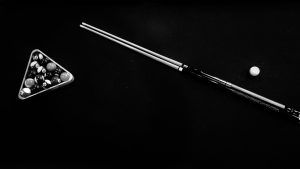Have you ever wanted to know how billiards got its start?
Well down below I have broken down the history of billiards for everyone. To appreciate where we are now with the game, you should know where it came from and how it got started. So to get started on our journey down memory lane lets get the basics out of the way.
What is Billiards?
Well when answering a question like this, a good place to look is a dictionary. So in the Merriam Webster Dictionary, billiards is defined as any of several games played on an oblong table by driving small balls against one another or into pockets with a cue. As you can see by this definition, billiards is not a single game but rather an umbrella term for any games played with a stick and a ball on an oblong table with either one of two objectives. Driving balls against one another or into pockets.
Why do some people call billiards pool? Are they different?
When people say pool, when referring to billiards, they are actually talking about a type of billiard games referred to as pocket billiards. The word pool means a collective bet or ante. Many games involve a pool, for example poker, but yet pocket billiards is what the name pool became attached to. The term pool room now means a place where pool is played, but it use to mean a betting parlor for horse racing. These betting parlors would have billiard tables so the betting patrons could pass time in between races. Over time as the game evolved, the term pool, even though many games use a pool, is always associated with pocket billiards.
So to make things easier to understand. We are going to break down billiards into three main sub-divisions of the game. You have Carom Billiards, Pocket Billiards, and Hybrids of the two. All three main sub-divisions have multiple individual games with their own set of rules.
Carom Billiards (or sometimes called French Billiards) is played on pocket-less tables typically ranging from ten to twelve feet in length using smaller balls. Pocket Billiards (or most of the time referred to as Pool) is played on tables that usually have six pockets and range from seven to nine feet in length. Hybrid billiard games tend to be in the middle between carom billiard and pocket billiards. They use the larger tables and smaller balls like carom billiards but their tables have pockets like pocket billiard games. Listed below are some of the different games that fall under the three main sub-divisions of billiards.
Carom Billiards
- Balkline & Straight Rail
- Three Cushion
- Four-Ball
- Five Pin
Hybrids
- Snooker
- English Billiards
- Russian Billiards
Pocket Billiards
- Eight Ball
- Nine Ball
- Ten Ball
- Straight Pool
- Bank Pool
- One Pocket
How did billiards get its start?

Billiards is believed to have derived from a lawn game similar to croquet played during the 15th century in Northern Europe. This lawn game over time got moved to indoors on a wooden table with green cloth to simulate the grass of the lawn game. I found that to be really interesting, I would of never thought that’s why most tables use green cloth.
So how did billiards get its name?
The term “billiard” comes from two words in the French language, “billart” and “bille“. Billart means wooden stick and bille means a ball. So you put the two together and you get stick ball. Which all billiard games today use balls and a stick or are referred to as a cue.
What is a cue and how did it get its name?
Before there were cue sticks, the billiard players used wooden maces, which were similar to the ones used in the original lawn game outside. The balls were pushed rather than struck similar to the game of shuffleboard.

The maces worked well when the balls were out in the middle of the table but problems were realized when the balls ended up close to the rail. The players began to turn the mace around and using the handle to hit the ball. The smaller size of the handle made it easier to hit the ball when on the rail. The handles were called a “queue” which means tail.
As the game evolved, so did the maces, they began using narrow tapered wooden sticks with leather tips, and today we call them cues. The cue stick ranges in weight from twelve ounces to 22 ounces, and the straighter the cue the better.




